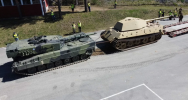Onpa huimasti nopeutunut varikkokäynti. Tosin selityksenä voi olla tankkauksen poistuminen?
Viimeksi muokattu:
Follow along with the video below to see how to install our site as a web app on your home screen.
Note: This feature may not be available in some browsers.



00:00 Intro 02:04 “I Wanted to Be a Navy SEAL”03:50 What Is a Navy SEAL and the Special 'Hell' Training 06:58 What It Takes to Become a Special Force Agent 08:59 What Is the Point of Working This Hard? 10:25 Can You Teach This Crazy Drive? 12:23 Is Our WHY Important?
15:36 Your Excuses Will Destroy You 20:10 The Hack to Build Confidence and Belief 25:04 Why Imposter Syndrome Is Necessary 29:22 Why the Special Forces Leaders Ask Their Team for Advice 34:03 The Craziest Missions and Things I've Seen... 36:56 The Dark Side of War and Losing Friends 47:44 Dealing with Sadness & Grief 52:39 Decision Making & Taking Action 01:00:19 From a Leader POV I'm the Proudest When My Team Does This
01:02:09 Why You Should Serve Others 01:05:16 Don't Do This If You Want a Promotion 01:08:31 Leaving the Military 01:13:39 Why Discipline Equals to Freedom 01:18:40 Create a Routine System in Your Life 01:22:11 The Biggest Misconceptions About the Military and Myself 01:26:02 Toxic Masculinity Traits 01:34:45 Finding Fulfillment & the Importance of Bonding 01:39:57 The Answer to Achieving Success 01:42:09 Work and Life Balance 01:47:24 The Last Guest Question
Kyllä kuskin pitää tuon verran jarruihin luottaa.Taitaisi jäädä tekemättä.



***Lactic acid isn’t the issue; it’s accumulating H+ from the insufficient reconstitution of ATP
To sustain muscle contraction, ATP needs to be regenerated at a rate complementary to ATP demand. Three energy systems function to replenish ATP in muscle: (1) Phosphagen, (2) Glycolytic, and (3) Mitochondrial Respiration.
it was not until the beginning of the 20th century that the biochemistry of energy metabolism began to be better understood. This led to a number of studies which indicated that lactate was a dead-end waste product of glycolysis and a major cause of muscle fatigue. However around the 1970s this view began to be challenged, and it has now been shown that lactate is in fact beneficial during intense exercise
It is fair to state that we could not sustain high-intensity exercise for much longer than 10 to 15 seconds without lactate production.
edit:The anaerobic (nonmitochondrial) system is capable of responding immediately to the energy demands of exercise and is able to support extremely high muscle force application and power outputs. Unfortunately the anaerobic system is limited in its capacity, such that either a cessation of work or a reduction in power output to a level that can be met by aerobic metabolism is seen during extended periods of intense exercise. The aerobic energy system responds surprisingly quickly to the demands of intense exercise, yet due to a relatively low rate of ATP turnover, is incapable of meeting the energy demands at the beginning of exercise, irrespective of the exercise intensity, or intense exercise. Nevertheless, it now seems evident that the aerobic system plays a significant role in determining performance during high-intensity exercise, with a maximal exercise effort of 75 seconds deriving approximately equal energy from the aerobic and anaerobic energy systems.
“Lactic acidosis” is incorrect because conversion of glucose to lactate is not acidifying and the increased proton production responsible for metabolic acidosis in hyperlactatemia results from ATP hydrolysis without ability to consume protons in oxidative phosphorylation
